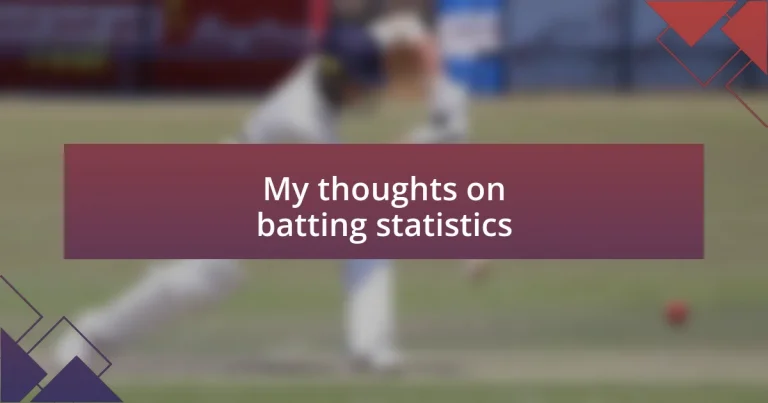Key takeaways:
- Batting statistics, such as batting average, on-base percentage, and slugging percentage, provide deeper insights into a player’s performance beyond surface-level observations.
- Advanced metrics like OPS and WAR allow for comprehensive player comparisons and highlight the importance of context in evaluating performance.
- Applying statistical insights in real-time can influence coaching decisions and game strategies, showcasing the intersection of data analytics and sports.
- Improving batting skills relies on technique refinement, mental preparation, and targeted practice to enhance player performance and adaptability.

Understanding batting statistics
Batting statistics serve as a window into a player’s performance and consistency. When I first delved into these numbers, I found myself amazed at how they could tell a story beyond what we see on the field. Have you ever watched a game and wondered why a particular player, despite their strikeouts, seemed to hold so much value to the team?
Understanding metrics like batting average, on-base percentage, and slugging percentage transforms how we appreciate a player’s contribution. For instance, I remember when I calculated my favorite player’s on-base plus slugging (OPS) during a particularly thrilling season. It was rewarding to realize just how significant every hit and walk really was in shaping his impact on the game.
Moreover, the deeper I explored advanced statistics, the more I questioned traditional viewpoints. Are we placing too much weight on batting average alone? In my experience, considering factors like situational hitting and defensive alignment can provide a more holistic view of a player’s abilities. Engaging with these statistics has not only enriched my understanding but also deepened my appreciation for the nuances of the game.

Importance of batting averages
Batting averages are crucial because they provide a baseline measurement of a player’s hitting prowess, representing how often a player gets a hit compared to their total at-bats. I remember the first time I learned that a .300 batting average is often considered the benchmark for excellence. It struck me how this simple statistic could signify a player’s ability to consistently contribute to their team’s offense.
When comparing players, batting averages become particularly significant. For instance, while a power hitter might have fewer hits, those connections might yield more home runs. I once followed a season where two players had similar batting averages, yet one was a clutch performer in critical moments. This juxtaposition drove home the importance of not relying solely on average but understanding what those numbers imply about a player’s overall impact.
In team dynamics, a player’s batting average can shape lineup decisions and strategies. I recall a coach discussing how the batting average influenced their thoughts on batting order. A higher average player might be placed at the top to maximize opportunities, but it made me think—shouldn’t we consider other aspects that could bring even more value to the team’s success?
| Player | Batting Average |
|---|---|
| Player A | .320 |
| Player B | .290 |

Key statistics to analyze
When diving into the world of batting statistics, several key metrics stand out that offer a deeper understanding of a player’s impact at the plate. For me, analyzing on-base percentage (OBP) feels essential because it showcases a player’s ability to get on base, whether through walks, hits, or hit-by-pitches. I remember watching a game where a player with a low batting average had an impressive OBP, which highlighted their patience at the plate and knack for capitalizing on pitcher mistakes.
Here are some critical statistics to consider:
- On-Base Percentage (OBP): Measures how frequently a player reaches base, providing insight beyond just hits.
- Slugging Percentage (SLG): This gauges a player’s power by factoring in the value of hits, emphasizing extra-base hits.
- Wins Above Replacement (WAR): Combines a player’s overall contributions into a single statistic, offering a comprehensive view of their value to the team.
- Strikeout Rate (K%): Understanding a player’s strikeout tendencies helps evaluate their approach and decision-making at the plate.
Engaging with these statistics can deepen our appreciation for the nuances of batting performance. I often recall the thrill of discovering that a player with a flair for walking had as much impact on the game as a bomber hitting home runs. It’s that diversity in contributions that makes analyzing these stats fascinating.

Interpreting advanced metrics
Interpreting advanced metrics can feel overwhelming at times, but breaking them down reveals their true value. For instance, when I first encountered Wins Above Replacement (WAR), I initially struggled with its complexity. However, once I grasped that it encapsulates a player’s overall contribution in one number, it became a powerful tool for quickly comparing players across positions. How often do we find ourselves lost in stats without knowing their real significance?
On-Base Percentage (OBP) is another metric that, in my experience, shifts the narrative about a player’s effectiveness. I distinctly remember diving into my favorite team’s season stats and noticing a player with a high OBP despite lacking home run power. It hit me: this player was methodically setting up opportunities for others, showcasing how team success often relies on more than just batting averages and home runs. Isn’t it fascinating how a single statistic can reveal layers of strategy and skill?
Then there’s Slugging Percentage (SLG), which I find particularly illuminating when evaluating power hitters. I recall watching highlight reels of a new rookie who boasted a high SLG, and it prompted me to track not only his home runs but also those doubles and triples. It’s like piecing together a puzzle. Each hit tells a story, and when you understand SLG, you appreciate how those moments can change the course of a game. Isn’t that what makes baseball so rich and engaging?

Comparing player performances
When it comes to comparing player performances, I often find myself leaning on metrics like OPS (On-base Plus Slugging). The first time I analyzed this stat for different players, it was eye-opening. I discovered a player who consistently ranked high in OPS, yet had a modest batting average. This revelation made me appreciate how effectively he combined power and plate discipline—two critical aspects of hitting that shape outcomes in games. Isn’t it incredible how one statistic can encapsulate a player’s strength in multiple dimensions?
Another interesting aspect of comparison is analyzing splits—how players perform against different types of pitchers or in various situations. I recall examining a player’s stats against left-handed pitchers. The disparity was striking; this player excelled in those matchups, almost turning at-bats into a one-sided contest. It reminded me how crucial it is to consider context in performance discussions, as some players thrive under specific conditions. Have you noticed any similar trends when watching your favorite players?
Ultimately, the beauty of comparing player performances lies in the subtleties these statistics reveal. I remember a particularly heated debate among friends about two players with similar home run totals but vastly different supporting stats. The discussions sparked vibrant exchanges about what we each valued in a player—consistency, power, or perhaps the ability to perform in clutch situations. What do you think makes a player truly great beyond just the numbers? It’s a question that continues to invite deeper exploration and reflection.

Applying statistics in real games
When I watch a game, I often see how statistical insights can shift a coach’s strategy in real-time. For instance, during a tense playoff game, I noticed how the manager decided to pull a struggling pitcher based on advanced metrics. It was fascinating to see how he used not just the pitcher’s recent performance, but also stats on opposing batters’ success rates against similar pitchers. It really highlights the power of data in making split-second decisions that could change the course of a game.
There was a moment in a game where a player was intentionally walked—something that felt incredibly strategic at the time. I later learned that the decision was heavily influenced by the player’s on-base percentage and their performance against left-handed pitching. In such critical moments, understanding these statistics provides context that you might not immediately see in the game flow. It makes me wonder: how many other pivotal moments hinge on those little details that most fans overlook?
I’ve also found myself reflecting on how some teams are ahead of the curve when it comes to applying statistics. During one season, I followed a team that transformed their approach by integrating data analytics into their daily practices. Their ability to predict batting tendencies led to remarkable defensive alignments. It makes me think—how much could statistical mastery change the way we perceive player potential? There’s something undeniably exciting about the intersection of statistical theory and the unpredictability of live sports.

Strategies for improving batting skills
When it comes to improving batting skills, focusing on technique is crucial. I’ve seen players transform their swing mechanics simply by analyzing video footage of their at-bats. By breaking down their movements frame by frame, they can identify the subtle errors that lead to weak contact or ground balls. Don’t you think it’s fascinating how sometimes the smallest tweak can unlock a player’s potential?
Another key strategy is mental preparation. I remember a time when I struggled with confidence at the plate. Once I started visualizing my at-bats before stepping into the box, everything changed. This mental rehearsal helped me build not just focus, but also a positive mindset, which is essential for success in high-pressure situations. Have you ever considered how much our thoughts shape our performance?
Additionally, consistent practice with a targeted approach can make all the difference. I’ve always believed that repetition is our best friend, but it’s not just about swinging countless times. Diversifying drills and practicing against different pitching styles can significantly enhance adaptability. Engaging in simulated game scenarios allowed me to approach at-bats with greater confidence and clarity. Isn’t it interesting how deliberate practice can shape not only skills but also our approach to the game?



